CGKB News and events Rice
DNA bank for cultivated rice, wild rice and related genera genetic resources
Contributors to this page: T.T. Chang Genetic Resources Centre-IRRI, Los Baños, Philippines (Ruaraidh Sackville Hamilton, Ken McNally, Flora de Guzman, Renato Reaño, Soccie Almazan, Adelaida Alcantara, Elizabeth Naredo); WARDA, Cotonou, Benin (Ines Sánchez); UPLB-University of the Philippines at Los Baños (Teresita Borromeo).
|
Contents: |
When DNA banks are used
DNA banks should be used for small core collections of accessions with the intention of repeated use for gene discovery. DNA conservation of rice germplasm is a short-term and expensive alternative. Due to difficulties of molecular characterization of heterogeneous populations, conserving materials as DNA is justifiable only for accessions with immediate value for intensive research.
The DNA bank serves as a cost-effective source for research on identical DNA samples. It does not replace conservation of the original accession as seed.
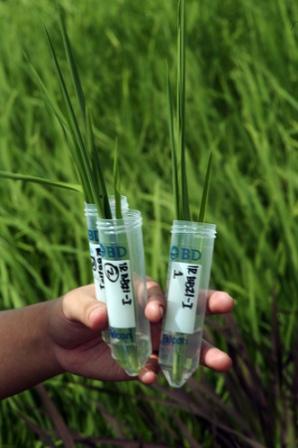 Taking rice leaf samples of transgenic lines that will be subjected to DNA extraction in the laboratory (photo: IRRI) |
Source of material (DNA acquisition)
Type of plant material
- Take leaf samples preferably from young healthy leaves (the maximum amount of good quality DNA is obtained from young leaf tissue grown in optimal conditions).
- Continue to grow the sampled plant(s) to maturity and harvest and conserve the seed (harvested seed will constitute the genetic stock that provides the exact match to the DNA).
- Maintain a sample as lyophilized leaf tissue samples and/or extracted DNA (to be conserved as lyophilized leaf samples while awaiting DNA extraction or as a backup for repeat extractions in case of difficulties).
- Apply strict quality control for quantification and verification of use in Polymerase Chain Reaction (PCR).
Amount of plant material
- 2-5 g from individual plants.
Pre-treatments
- None.
Sample preparation
DNA extraction and purification
- According to modified CTAB (Fulton et al., 1995).
DNA replication/multiplication
- DNA samples should be obtained from individual plants (sampling from individual plants is necessary for population structure studies. Depending on the purpose, judicious bulking of plants may be desirable, improving throughput at the expense of reducing information content).
- Use of bulks for accessions that are heterogeneous may lead to difficulty depending on purpose.
Sample packaging
- Store purified samples in 1.5 to 2.0 ml micro centrifuge tubes (storage in plates can lead to cross-contamination).
Recording information during sample processing
The following information must be recorded for each processing step:
- Accession ID (an ID number).
- Seed crop year (year and season of production of the parental seed used to grow the plants from which DNA was extracted).
- Date (date of DNA extraction).
Viability and routine monitoring
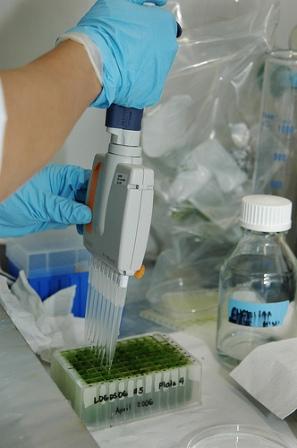 An agricultural research technician performs a Polymerase Chain Reaction (PCR) procedure to determine the presence of alleles or genes with known function or importance (photo: IRRI) |
Storage DNA quality monitoring
Type of test
- Random check using tested PCR markers (verifies that stored samples are usable for molecular analysis).
Number of replicates
- Three.
Frequency
- Annual.
Minimum number of samples
- 96.
Recording information during DNA storage monitoring
The following information must be recorded for each step:
- Accession ID (an ID number).
- Seed crop year (year and season of production of the parental seed used to grow the plants from which DNA was extracted).
- Date (date of DNA extraction).
- DNA concentration.
- DNA concentration date (date on which DNA concentration was measured).
- Comments (DNA quality – visual inspection from agarose gel eletrophoresis).
Storage specifications
Storage conditions
- Store at -20°C for active use (DNA stored at -20°C is usable for at least 2-3 years).
- Store at -80°C for long-term (DNA stored at -80°C is expected to have longevity increased to ten or more years).
Duration of storage
- Depends on results obtained from DNA quality monitoring (despite optimum conditions for storage DNA samples can get degraded through time because of unavoidable freeze-thaw cycles).
Legal arrangements
- Intellectual Property issues may arise associated with the extraction and analysis of DNA: these should be recorded if they affect usage.
- DNA exchange should, like seed exchange, be done under a Material Transfer Agreement (MTA). This will usually be the SMTA if the source germplasm is also distributed under the SMTA (see examples in six languages).
Safety duplication
Since DNA conservation is justified only as an additional measure for cost-effective support of active research, not replacing the seed sample, the concept of safety duplication does not normally arise.
Storage management in DNA banks
System for tracking material/inventory system
- Barcoded samples with amounts handled by inventory tracking (barcoding allows automated sample tracking and an inventory system indicates current supply).
Recording information during DNA storage
The following information must be recorded for each step:
- Accession ID (an ID number).
- Seed crop year (year and season of production of the parental seed used to grow the plants from which DNA was extracted).
- Date (date of DNA extraction and storage).
References and further reading
Fulton TM, Chunwongsw J,
Registration of cultivated rice, wild rice and related genera genetic resources
Contributors to this page: T.T. Chang Genetic Resources Centre-IRRI, Los Baños, Philippines (Ruaraidh Sackville Hamilton, Ken McNally, Flora de Guzman, Renato Reaño, Soccie Almazan, Adelaida Alcantara, Elizabeth Naredo); WARDA, Cotonou, Benin (Ines Sánchez); UPLB-University of the Philippines at Los Baños (Teresita Borromeo).
Verifying accompanying documentation
A minimal documentation is essential to track germplasm material. Health and IPR certificates are very important for entry into the country. The following documents should accompany each consignment of plant germplasm:
- An appropriate Material Transfer Agreement (MTA) or other contract must be used for all acquisitions (preferably the SMTA where possible. It is essential to know conditions of conservation and use, and the rights and obligations of donor and receiving genebank).
- Phytosanitary certificate from the donor (if required by the laws of the country of the receiving genebank).
- Import permit (if required by the laws of the country of the receiving genebank).
- GMO declaration (avoiding the unintentional presence of transgenes in supposedly non-transgenic germplasm is becoming of increasing concern to many countries. A declaration of the measures taken by the donor is now considered desirable for GM risk management by the receiving genebank, and to enable it to make required GMO declarations to subsequent recipients).
- List of germplasm samples in the consignment.
- Associated passport data, preferably in the multi-crop passport descriptors (MCPD) format, preferably electronically.
- Other associated available, non-confidential descriptive data, preferably electronically.
Verifying the consignment
This is the accession of new samples into the collection before formal registration (additional tests and procedures that must be completed before the sample can be considered fully accessed into the collection, safely conserved and available for distribution).
Checking the genebank
This is important to verify the legitimacy of the material, to avoid the introduction of new pests and diseases and the storing of dead material, as well as to assure that only seeds that appear in good condition and have a high probability of being viable are registered.
- The next criterion to accept new material in the genebank should be to check if the same material is already present.
- Passport data and phenotype descriptors-characterization data must be used for verification of the possible duplicates as a first step.
Checking the content
This is very important to avoid conserving duplicates and to have complete information on genebank accessions. This data enhances the value of the germplasm.
- Check the accompanying papers of the consignment: seed list, passport and other associated data, phytosanitary certificate and import permit.
- Check the seeds and compare the labels on seed packets with those in the accompanying seed list.
- Note discrepancies, missing data, missing samples.
- Send the donor a letter of acknowledgment stating date of receipt, status of seeds and, if necessary, requesting clarification of any discrepancy.
- File a copy of the seed list and other accompanying documents.
- Release seeds and documents to the genebank with recommendations on the appropriate health protocol.
Checking the germplasm
- Take the consignment to the authorized quarantine laboratory for post entry quarantine inspection.
- Test viability of the newly received seeds:
- If the sample is too small for a standard germination test, reduce the number of seeds used for the test.
- If the sample is small or the viability is low, retain the germinated seeds and use them to plant a regeneration plot at the earliest possible date.
- If sufficient original seed is still available, put aside a small sample (about 20 seeds) as the ‘seed file’. (‘Seed file’ is a small subsample of seed – preferably original seed, otherwise seed from the first successful multiplication-set aside to serve as the definitive reference sample of the accession, against which all new harvests of the same accession are compared). The seed should be kept dry and free from pests and diseases, but easily accessible for cross-referencing with new harvests.
- Complete all procedures (as described for sample processing of cultivated or wild rice) on the initial seed to multiply, clean and dry until the samples have been fully processed and are ready to be stored for conservation and made available for use, with a reference seed sample set aside in the seed file. Repeat cycles of viability testing for cultivated or wild rice and regeneration of cultivated or wild rice as often as necessary to produce enough seed for conservation and use, or until all the original seed has been used.
Assigning Numbers
When is the moment to assign an accession ID? There are no common agreed standards but there are generally two options:
- Option 1: assign an accession ID as soon as a sample is received by a genebank, before it has been truly accessed into the collection. In this case, many accessions will never become active accessions as they may be rejected for any number of reasons – duplication, policy, failure of donor to comply with required legal and other procedures, rejection of SMTA by recipient, health/quarantine problems, problems of contamination or mislabelling, viability problems, regeneration problems, throughput bottlenecks.
- Option 2: assign an accession ID only after the sample has been fully accessed into the collection i.e. all initial checks have been passed and sufficient healthy seed is produced to be sure the sample can be conserved and distributed. In this case, there will be very few non-active accessions, but incoming samples will need to be assigned a temporary ID in order to track their progress through the initial tests and other processes.
- IRRI operates and suggests the second option.
Advantages of second option:
It facilitates tracking of samples through the initial process of accessing a sample into the collection.
It also facilitates the distinction, for performance monitoring purposes, between the loss of fully-accessed samples (a serious problem) and failure to complete the process of accessing them into the collection (a common feature with samples received in poor condition- this is not related to genebank performance).
Disadvantages of second option:
It requires the use of a second, temporary ID for tracking progress through the initial process of accessing the incoming sample into the collection.
On successful completion of the above described procedures, the incoming seed have been fully accessed into the collection; assign an accession ID now.
- If any original seeds remain after completing these procedures, keep them to be conserved in ideal conditions in the long-term store as the ‘Most Original Sample’, separate from the standard samples of the base collection.
- Assign Seed Lot IDs to seed lots to be conserved in the active and base collections. (‘Seed Lot ID’ is used when one accession will undergo a number of generations of seed multiplication / regeneration; and each generation comprises a number of different packets of seed serving different purposes. In order to track progress through generations and monitor the location and status of each packet, it is necessary to be able to identify each seed lot of each generation separately – the Seed Lot ID enables this tracking)
- Prepare labels as described below and finally pack prepared cleaned seed in labelled seed packets for the seed file, active collection, base collection, MOS and safety backup collections.
Recording information during registration
The following information must be recorded for each consignment:
- Incoming consignment ID.
- Data associated with consignment: date of receipt, donor, number of samples, details of MTA or other contract and other documents.
- Temporary identifier (not accession ID) for each germplasm sample (accession IDs will be assigned after the seeds have been completely processed for conservation and distribution. Until then, temporary IDs are needed to document progress in processing, testing and initial seed multiplication).
- All received passport and associated descriptive characters for each sample.
- Data for monitoring progress through initial testing and processing: seed health tests, seed viability tests, initial seed multiplication.
- Amount of remnant original seed still available for testing and processing.
References and further reading
Bioversity International, IRRI and WARDA. 2007. Descriptors for wild and cultivated rice (Oryza spp.). Bioversity International, Rome, Italy; International Rice Research Institute, Los Banos, Philippines; WARDA, Africa Rice Center, Contonou, Benin. Available here. (1.2 MB).
FAO/IPGRI. 1994. Genebank standards. Food and Agriculture Organization of the United Nations, Rome and International Plant Genetic Resources Institute, Rome. Available in English, Spanish, French and Arabic.
Standard Material Transfer Agreement (SMTA). [online] Available from: http://www.planttreaty.org/content/what-smta. Date accessed: 15 July 2013.
Viability of cultivated rice genetic resources
Contributors to this page: T.T. Chang Genetic Resources Centre-IRRI, Los Baños, Philippines (Ruaraidh Sackville Hamilton, Ken McNally, Flora de Guzman, Renato Reaño, Soccie Almazan, Adelaida Alcantara, Elizabeth Naredo); WARDA, Cotonou, Benin (Ines Sánchez); UPLB-University of the Philippines at Los Baños (Teresita Borromeo).
|
Contents: |
|
Laboratory methods
Type of test
- Standard germination test (modified ISTA).
- Apply tetrazolium test to seed that fail to germinate, to determine whether seeds are non-viable or dormant.
Number of seeds and replicates
- Initial viability: if sufficient seed is available use 100 seeds with 2 replicates.
- Active collection: 100 seeds with 2 replicates.
- Base collection: 50 seeds with 2 replicates.
- Repeat if the difference between the two replicates exceeds the maximum difference expected from a binomial distribution at a probability of 2.5%.
Pre-treatment
- Break dormancy at 50oC for ten days for newly harvested seed or seven days for seed removed from storage.
- Equilibrate at room temperature for 2-3 days.
Media
- Use moist paper for standard tests.
- Use Petri dishes lined with moist paper where the standard test gives unreliable results.
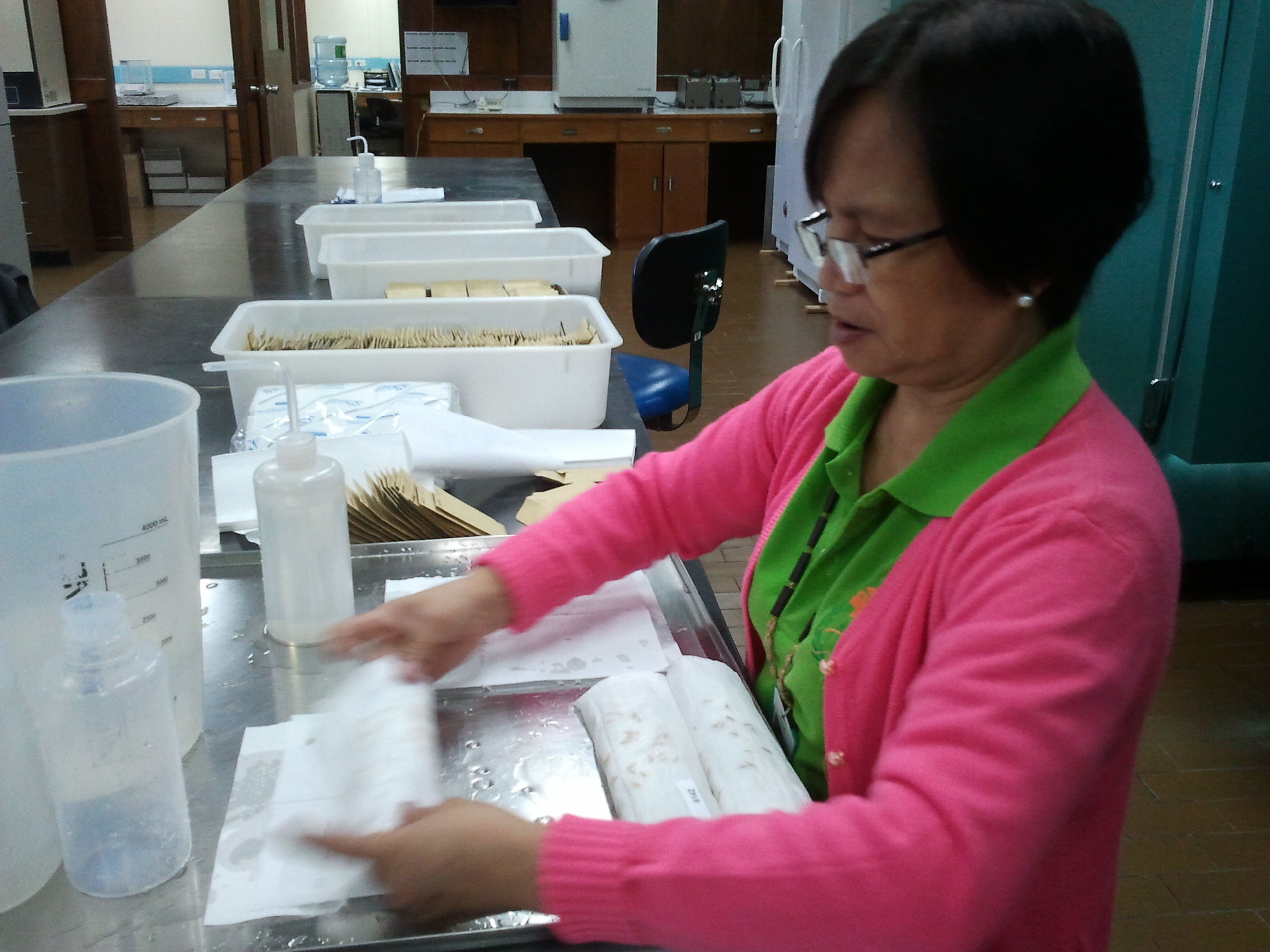 |
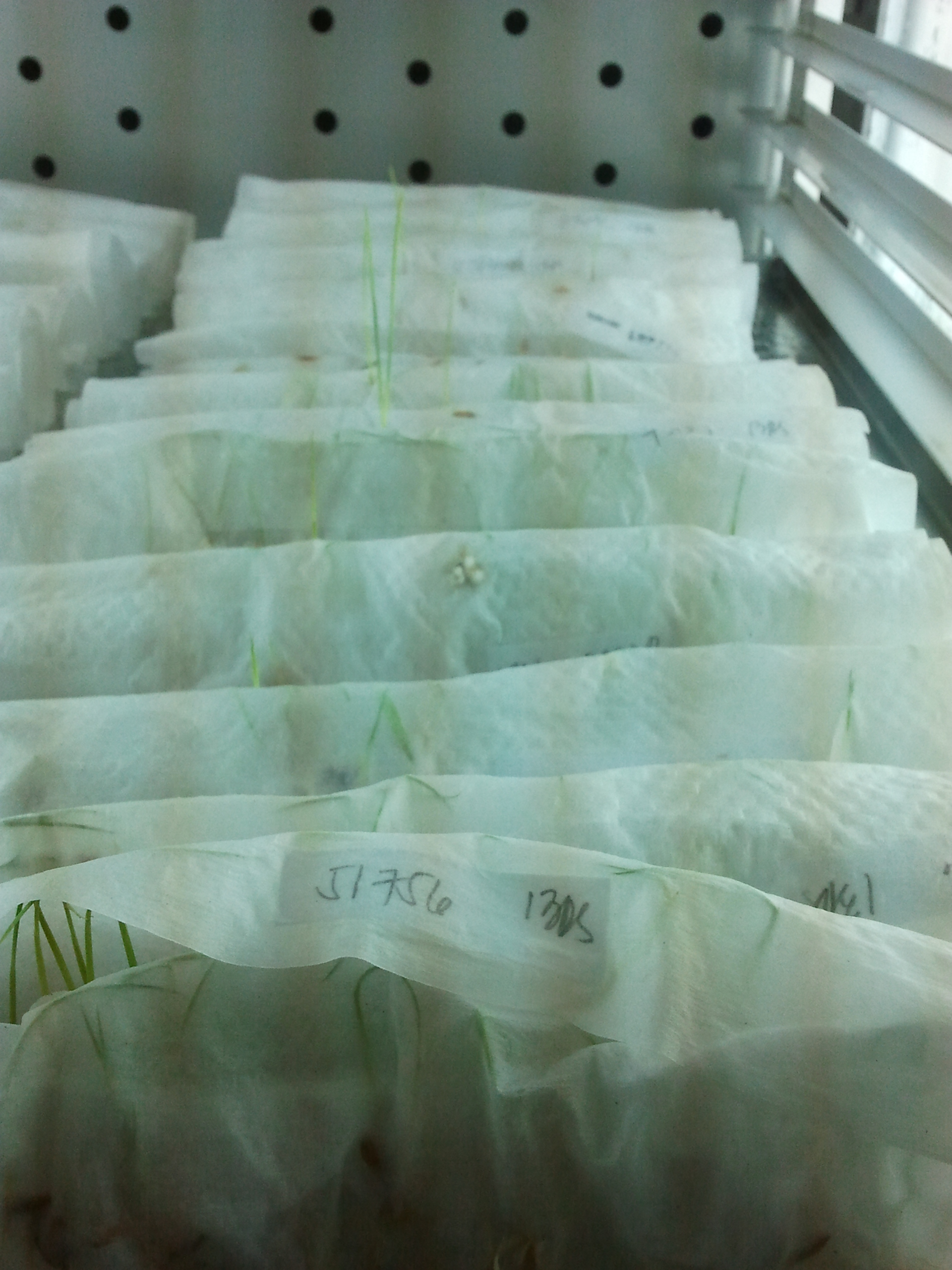 |
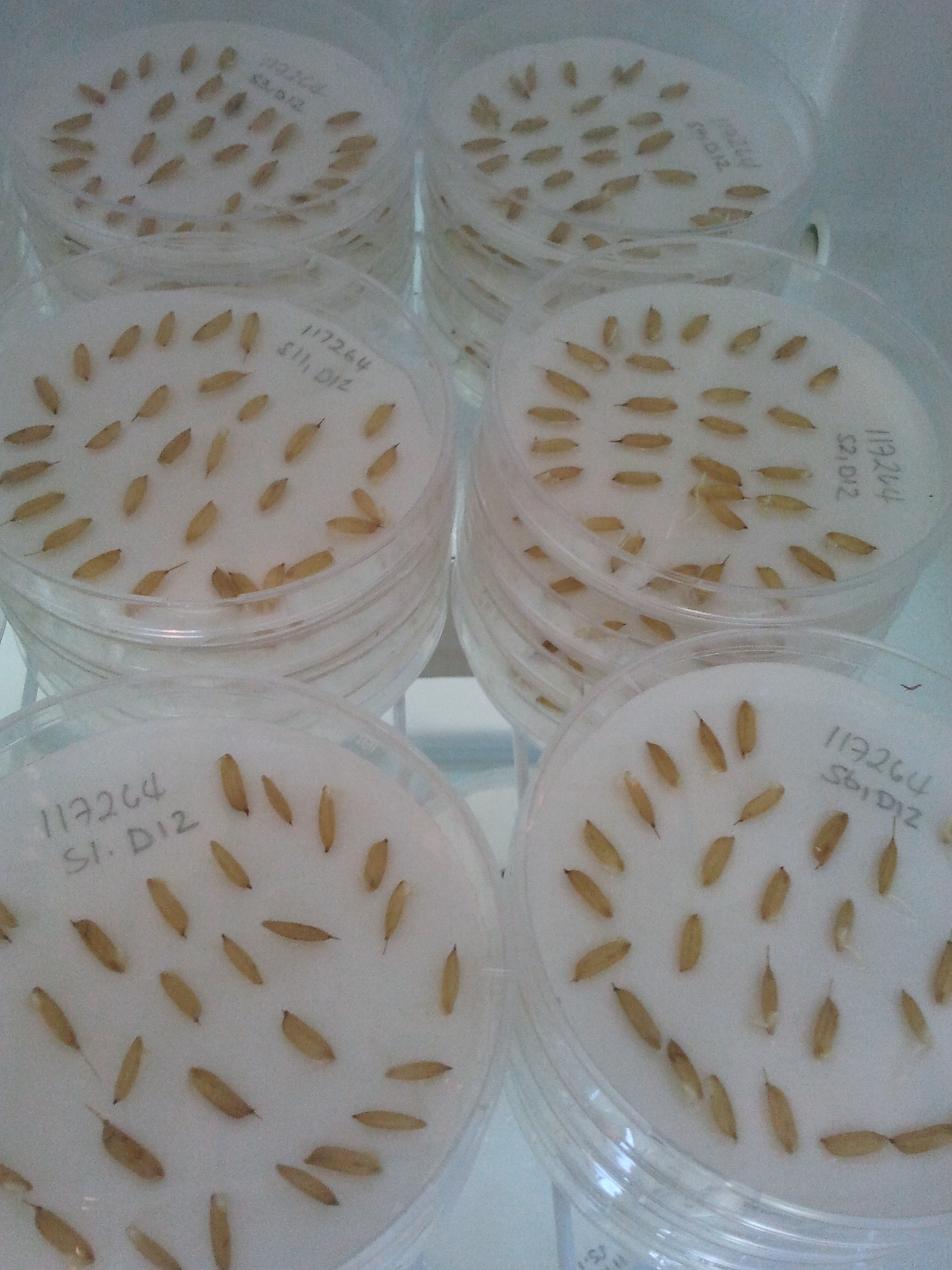 |
|
Preparation of rice seeds for germination testing in moist paper at IRRI (photo: Fiona Hay, IRRI) |
Rice germinating in moist paper at IRRI (photo: Fiona Hay, IRRI) |
Rice germination in Petri dishes at IRRI (photo: Fiona Hay, IRRI) |
Temperature/ Humidity
- 30oC, 100% RH.
Light
- 12/12 hours light/dark.
Duration of test
- 7-28 days.
Others
- Count the number of normal and abnormal seedlings seven days after germination.
- If necessary take a second reading at 14 days.
- Test hardness of remaining ungerminated seeds.
- If still hard, dehull and place again in the germination chamber.
- If they still do not germinate, apply tetrazolium test.
Monitoring intervals
- Base collection - every ten years.
- Active collection - every five years.
Recording information during viability testing
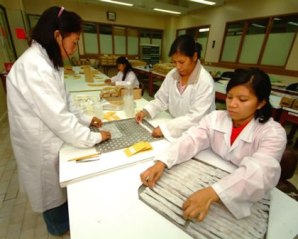
Seeds are germinated to check its viability and recorded |
The following information should be recorded for each testing step:
- Germination date (date of germination).
- No. Tested (number of seed tested).
- Germination % in replication 1 (%).
- Germination % in replication 2 (%).
- % germination mean (system-calculated mean for the % germination).
- Germination retest (germination % of the re-tested sample).
- Accession (list of accessions tested).
- Date counted (first count at 7 days and second count at 14 days).
- Normal seedling (seedlings that are free from decay, have well-developed primary root systems, have well-developed and intact coleoptiles).
- Abnormal seedling (seedlings not well developed).
- Assumed dormant seeds (hard but non-germinated seeds).
- Dead seeds (rotten seeds).
- Germination % (the percentage of normal seedlings).
Describes the recommended monitoring methods to assure minimum viability and quantity of seeds in storage.
Methods
Determine which samples require testing:
- Newly received or harvested samples, and samples that have been in storage for the prescribed monitoring interval (5/10 years in active/base collection) since their previous viability test.
- Exclude samples with less than the minimum required quantity of seeds (60g): they will be scheduled for regeneration even without germination test.
-
If the number of samples to be tested exceeds current testing capacity:
- Prioritize accessions with the lowest germination rate at the previous test.
- Schedule a continuous series of tests until backlog has been processed.
- When no samples remain to be tested, calculate and schedule the next due testing date.
- Prepare the seeds. Locate and remove the seeds from cold storage. Allow to equilibrate to room temperature before opening.
- Do the germination test following the guidelines (see viability testing procedure).
- If the % germination has declined to 85% of the initial germination, mark the accession in the database as unavailable for distribution and schedule for urgent regeneration.
Monitoring frequency
Recommends the minimum quantity and minimum viability of seeds below which they need to be regenerated.
Critical quantity
- Each time seeds of an accession are removed from storage, for whatever purpose, re-weigh and update the computerized inventory before replacing the accession back in storage.
- Use barcoded labels with computerized inventory management system linking the balance to the database.
- If the quantity remaining is less than 60g (twice the amount needed for a regeneration planting) mark the accession in the database as unavailable for distribution and schedule for regeneration.
Critical germination level
- 85% of initial viability.
Recording information during routine monitoring
The following information should be recorded for each step:
- Accession ID (ID of accession).
- Seed Lot ID (ID of this sample of the accession).
- Crop season (year and season the seed was harvested).
- Store – temporary, active bulk, active pre-pack, base, primary safety backup, secondary safety backup (type of storage and packing for this sample).
- Species (O. glaberrima or O. sativa).
- Germination % (2 replications) (germination % - separate values for each replication; new record for each test).
- Germination test No. (number of seed per replicate used for testing germination %).
- Germination date (date of germination test; new record for each test).
- Seed amount units – grams, number of packets (units used to record the amount of seed of this sample).
- Seed amount (amount of seed in store; new record for each update).
- Inventory date (date the amount was last updated; new record for each update).
Health diagnosis of rice genetic resources
Contributors to this page: T.T. Chang Genetic Resources Centre-IRRI, Los Baños, Philippines (Ruaraidh Sackville Hamilton, Ken McNally, Flora de Guzman, Renato Reaño, Soccie Almazan, Adelaida Alcantara, Elizabeth Naredo, Patria Gonzales); WARDA, Cotonou, Benin (Ines Sánchez); UPLB-University of the Philippines at Los Baños (Teresita Borromeo); CIMMYT- Global Wheat Program (Etienne Duveiller).
List of diseases of quarantine importance
Click here for more detailed outputs from the page on the safe movement of germplasm, on this site.
The list below mentions some of the diseases that were considered important worldwide, but many of them may or may not have relevance in specific countries. It also does not consider diseases of limited relevance (e.g. only important in very few countries).
Bacteria
- Bacteria leaf blight (Xanthomonas oryzae pv oryzae).
- Bacterial leaf streak (Xanthomonas oryzae pv oryzicola).
Nematodes
- White tip (Aphelenchoides besseyi).
Fungal diseases
- Bacanae and foot rot (Fusarium moniliforme).
- Brown spot (Bipolaris oryzae).
- Leaf scald (Microdochium oryzae).
- Blast (Pyricularia oryzae).
- Kernel smut (Tilletia barclayana).
- Sheat rot (Sarocladium oryzae).
Options for testing procedures
Recommended methods to detect the presence of each disease:
- Seed borne fungi (Blotter test).
- Bacteria (seed wash assay using semi sel).
- Nematode (modified Bachmann funnel method).
Testing intervals/seasons
Testing before material goes into the genebank or to the field is important to reduce transfer of diseases or pests.
- Apply routine seed health test prior to storage.
- Samples that do not pass the test should not be entered into the active or long-term collection. Instead they should be stored temporarily, treated if possible and scheduled for early seed multiplication with treatment.
- Testing is not needed during storage (the low temperate and humidity of storage prevents the increase of pests and diseases, so no further testing is needed).
- Testing prior to distribution depends on the phytosanitary requirements of the requestor’s country.
Recording information during health diagnosis
The following information should be recorded for each step:
- See seed health testing data sheet (http://books.irri.org/9712200493_content.pdf).
References and further reading
ISTA. 2008. Detection of Pyricularia oryzae on Oryza sativa (Rice). International Seed Testing Association (ISTA), Bassersdorf, Switzerland. Available from: http://www.seedtest.org/upload/cms/user/7-011.pdf. Date accessed: 15 June 2010.
Mew TW, Misra JK, editors. 1994. A Manual of Rice Seed Health Testing. International Rice Research Institute, Los Banos, Languna, Philippines. Available from: http://books.irri.org/9712200493_content.pdf. Date accessed: 15 June 2010.
More Articles...
Subcategories
-
main
- Article Count:
- 1
-
Regeneration
- Article Count:
- 3
-
Conservation
- Article Count:
- 1
-
Safety duplication
- Article Count:
- 1
-
Characterization
- Article Count:
- 3
-
Conservation - Wild Rice
- Article Count:
- 7
-
Conservation - Cultivated Rice
- Article Count:
- 13





